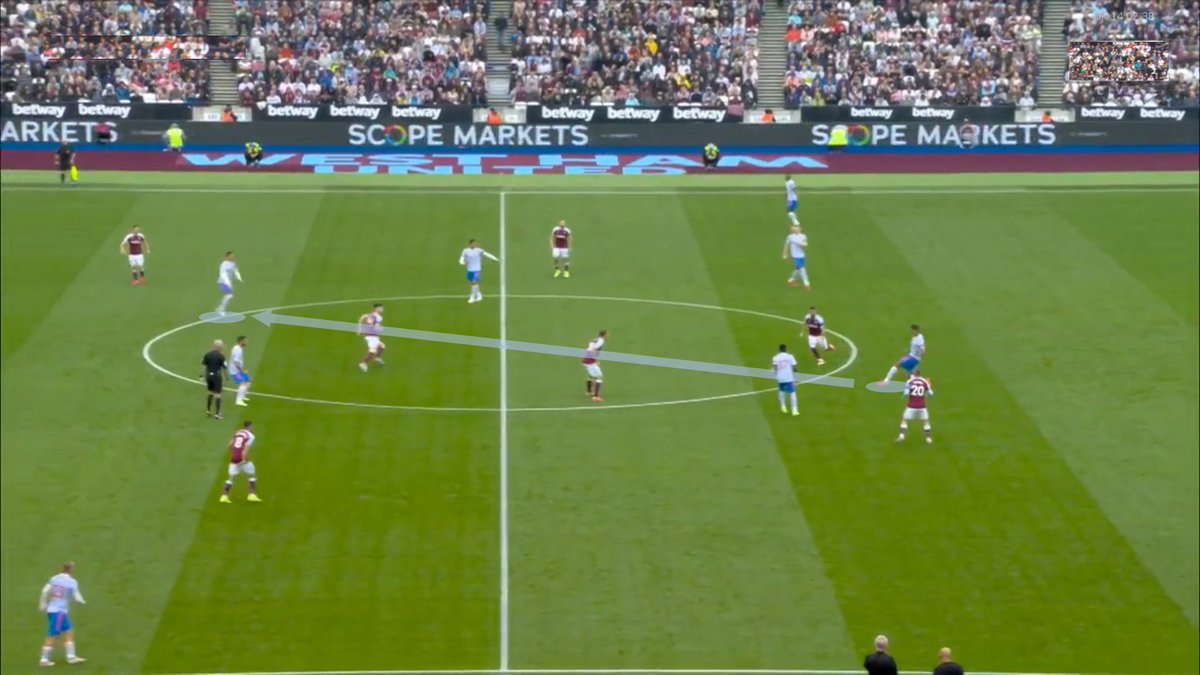
📌 Manchester United's Foundations in Possession: West Ham vs Man Utd [THREAD]:
- Varane carrying centrally
- McTominay dropping in right half space
- Fred semi-dropping
- Midfield/Forward line rotations to receive
- United access between the lines consistently early on
- Varane carrying centrally
- McTominay dropping in right half space
- Fred semi-dropping
- Midfield/Forward line rotations to receive
- United access between the lines consistently early on

1) Varane’s in build up:
When Varane had no vertical passing option, he often shuttled diagonally towards the centre of the pitch. This gave time for United’s Mid/Forwards to rotate and create an option, plus Varane’s carries prevented him from stagnating United’s possession.

When Varane had no vertical passing option, he often shuttled diagonally towards the centre of the pitch. This gave time for United’s Mid/Forwards to rotate and create an option, plus Varane’s carries prevented him from stagnating United’s possession.


Such a sequence is shown below, where Varane ultimately did not get a vertical option, thus could switch to the underloaded left, or play via Fred.
Again, we can see Varane move into the centre of the pitch on the ball, rather than merely carry in the half space. Varane could ultimately access Ronaldo between the lines with a vertical pass. Central progression is an ideal outcome from build-up. 



A centreback carrying towards the centre of the pitch isn’t conventional, but as mentioned, it did give time for passing lanes to be opened by recipients, while Varane could still make (relatively) progressive carries into the 2nd phase.
Varane’s tendency to drift centrally was conducive of McTominay dropping into the back line to make a three. This is an example of an on the ball movement dictating the action of a teammate. 



McTominay could access the front line, from the right half space, with vertical passes. The front line rotated well to receive in such scenarios.
Fred would also drop in a similar fashion to McTominay, but when Varane and Maguire remained split. With West Ham’s front two fairly man-oriented to United’s two CBs, Fred could semi-drop to receive, turn and progress. 

United often progressed centrally, before playing out to either fullback. This is where limitations of United’s system occur – particularly in the lack of structure of the front four: Ronaldo, Greenwood, Pogba and Bruno.
We can see in this still frame, how United have great potential in this circumstance, with four options between the lines. Due to lack of rigid organisation, United often failed to open lanes into these players from this position. 

On the left, it was a similar scenario, but Pogba offered an intermediate option for Shaw to play through to reach central zones. But ultimately, United struggled to consistently turn 2nd phase potential into final third penetration.
So what is the point of this thread, in the context of United's tactical and positional setup: with positives and limitations?
1) United have has good positional structure in build-up, for a substantial period of time under Ole.
United use the 3-1 to beat the first line of pressure, and are becoming better at dictating games from build-up. Varane's addition could help this, despite his limitations.
United use the 3-1 to beat the first line of pressure, and are becoming better at dictating games from build-up. Varane's addition could help this, despite his limitations.
2) We all know United don't have the most rigid, disciplined framework in the attacking third. They're fluid and allow individuals to roam and create - mainly Bruno, but now also Pogba off the left.
This is fine, if the fluidity is balanced and functional.
This is fine, if the fluidity is balanced and functional.
The key point of this thread:
3) We are starting to see more evidence of United showing coached, methodical rotations from the midfield and forward line, to create options for vertical passes. United consistently showed this within phases of dominance vs West Ham.
3) We are starting to see more evidence of United showing coached, methodical rotations from the midfield and forward line, to create options for vertical passes. United consistently showed this within phases of dominance vs West Ham.
3b) If United progress in this manner, and consistently show evidence of coached rotations, functional movements to receive and dictate the action of the passer in the 2nd phase, then the limitations of a fluid final third setup can be minimised...
In other words - we will have the framework in place to access the front line consistently enough, that they will produce in most games, despite a lack of rigid setup once they do receive.
More work is to be done to ensure their autonomy and freedom isn't detrimental.
More work is to be done to ensure their autonomy and freedom isn't detrimental.
It is a process, and hopefully, we will see more evidence of progress to mask our limitations.
• • •
Missing some Tweet in this thread? You can try to
force a refresh









